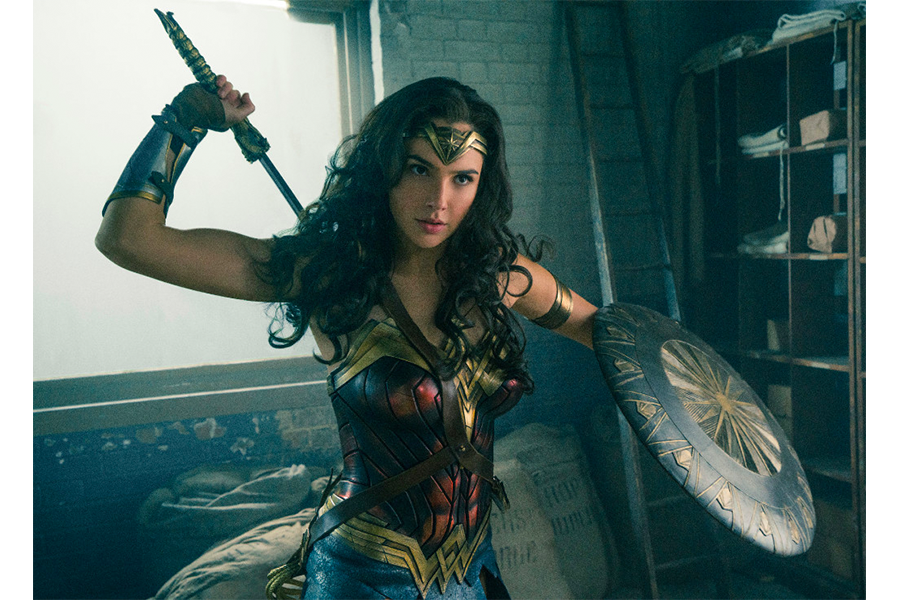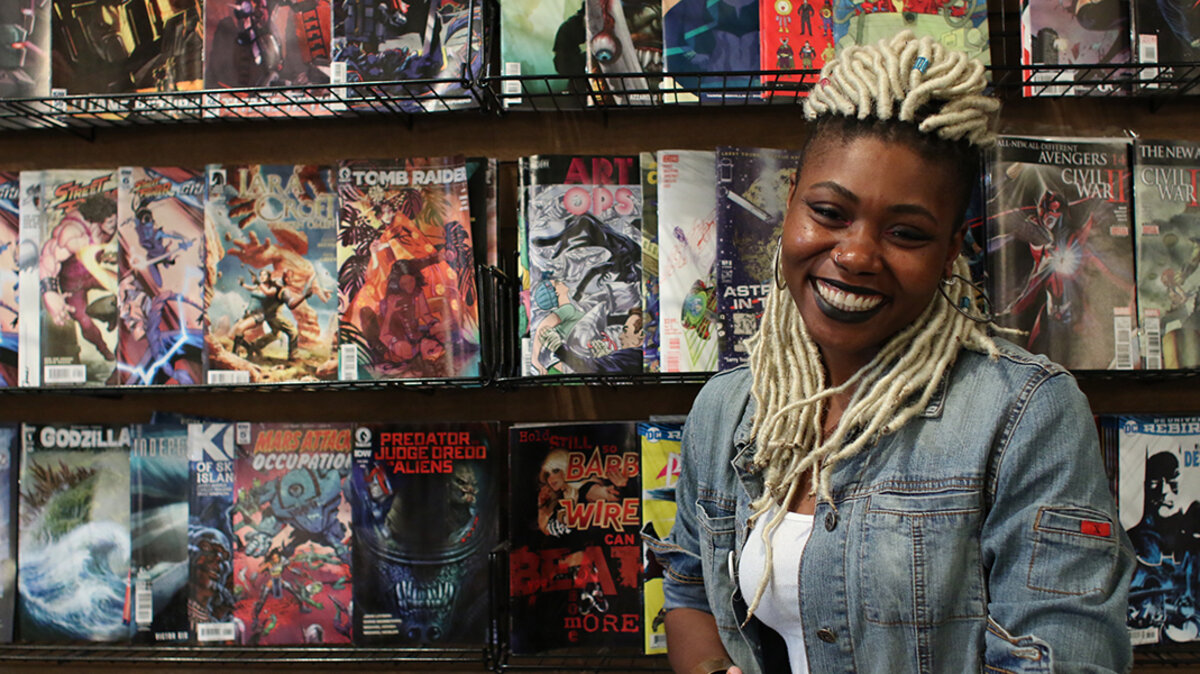Why female comic book fans are cheering for 'Wonder Woman'
Loading...
Ariell Johnson had been a fan of TV shows like “He-Man and the Masters of the Universe,” “She-Ra: Princess of Power,” and “Thundercats” – “things with superpowers and enchanted weapons and things like that,” she says. But when she began watching the “X-Men” TV series that aired beginning in 1992 on the Fox Network, she experienced a first.
“Through that cartoon, I was introduced to Storm,” Ms. Johnson says. “I had never seen a black woman represented in those genres.”
Storm, a superhero who controls the weather, inspired Johnson to begin reading comic books. Today, she’s the owner of Philadelphia’s Amalgam Comics & Coffeehouse.
“When I go into comic book stores, I would often be the only black person or the only woman in the space and that can be intimidating,” she says of her decision to open her establishment in 2015. “It can be uncomfortable and depending on the type of store you're in, it's not always a positive experience because people can be hostile to you because of those differences…. My goal with the shop is to make sure no one ever feels like that coming in.”
Johnson is one of a growing number of female comic book readers snapping up comic books like Muslim author G. Willow Wilson's "Ms. Marvel" series starring Kamala Khan. While Nielsen-like numbers are hard to come by, a November 2015 report by the website Graphic Policy intrigued many when it reported that women made up more than 51 percent of the people who said they were comic book fans on Facebook.
Meanwhile, Storm, played by Oscar winner Halle Berry, got her big-screen debut in 2000’s “X-Men.” It would take 17 more years for the first, and most iconic, female superhero, to get her own movie. “Wonder Woman” opens Friday to Amazonian-sized expectations.
Superman has been leaping tall buildings since the 1970s and comic book movies have been reliable (if not infallible, see: “Green Lantern” and “Fantastic Four,” any version) blockbusters for decades. But it took 76 years for Wonder Woman to make her big screen debut. Alisa Perren, co-author of the forthcoming book, “The American Comic Book Industry and Hollywood,” suggests this is due to outdated attitudes about who reads comic books and watches movies featuring loners with unusual abilities.
“[There’s] this sort of primary emphasis on young male audiences as the sort of focal point as well as the perception, whether legitimate or not, that those are the primary readers and consumers, which much of the data indicates is less and less the case for comic properties and crossover properties…,” says Dr. Perren, who is also associate professor in the department of radio-TV-film at the University of Texas, Austin. “The perception is more that the men will bring the women along but the women won't bring the men along.”
For the most recent Marvel film, May’s “Guardians of the Galaxy 2,” 44 percent of the audience who went to see the movie in its opening weekend were women. And in 2014, Publishers Weekly said the fastest-growing audience for comic books was women ages 17 to 33.
While female characters like Guardians’ Gamora, X-Man Storm, and Avenger Black Widow have been part of world-saving ensembles, the last woman to helm a superhero movie was Jennifer Garner in 2005’s “Elektra.” “Wonder Woman” also features something harder to find than an invisible plane: a woman, Patty Jenkins, directing a big-budget superhero movie.
“We have a female carrying a large tent-pole film, which is extraordinary,” Stacy Smith, a professor at the University of Southern California who studies diversity issues in Hollywood, told the Los Angeles Times. “‘Wonder Woman’ is absolutely a step in the right direction.”
Perren says that fairly or not, “Wonder Woman” will serve as a test case for many Hollywood executives.
“I feel like we have all these stories and narratives starting to form and decisions that are like waiting to be made based on what happens with it,” she says. “Which unfortunately is the history of these very rare occasions when women have leading roles in front of or behind the camera, that one property and its success is then extrapolated to be evidence of viability writ large. Whereas that doesn't happen, of course, when ‘Green Lantern’ fails.”
Overall, the comic book universe – in print and on screen – is clearly becoming more diverse. Other big-screen projects putting people of color and women front and center are 2018’s “Black Panther” starring Chadwick Boseman, 2018’s “Aquaman” starring Jason Momoa, and 2019’s “Captain Marvel” starring Brie Larson. Perren says that TV has done a better job of showcasing female and minority characters, such as ABC’s “Agents of S.H.I.E.L.D.” and Netflix’s “Jessica Jones” and “Luke Cage.”
When Iron Man is a teenage girl
But the comic books themselves have gone further than their onscreen incarnations. Take Marvel, for example: Iron Man is actually now a black teenager named Riri Williams, and Spider Man is an Afro-Latino teen named Miles Morales.
Not all fans have reacted with joy at seeing a female Thor wielding Mjolnir, the magical hammer. Besides the predictable outrage of certain segments of social media, a Marvel executive said this spring that the publisher’s emphasis on diversity was hampering sales.
“What we heard was that people didn't want any more diversity. They didn't want female characters out there,” Marvel vice president of sales David Gabriel said in an interview. “That's what we heard, whether we believe that or not. I don't know that that's really true, but that's what we saw in sales.”
He later walked back the comments, saying, “Let me be clear, our new heroes are not going anywhere! We are proud and excited to keep introducing unique characters that reflect new voices and new experiences into the Marvel Universe and pair them with our iconic heroes."
Jesse Farrell, manager of Hub Comics in Somerville, Mass., agrees with those who said that there is far more to the story behind the sales numbers than just diverse characters.
“There has been a general dissatisfaction with Marvel in the last couple of years and I think it has more to do with increasing prices, brand dilution, a cycle of cancellation and restarting new No. 1s,” he says. “And every time they do that, there’s a brief bump up in sales but we also sort of lose longtime readers every time they do a relaunch.”
He does see a disadvantage in the way some of these characters are presented, however. When someone like the African-American Sam Wilson becomes Captain America, he is taking over for the white Steve Rogers.
“What I’m sometimes afraid happens is that people are just waiting for the ‘real’ Captain America to come back and take the role over again…,” he says. “I think that sometimes, what happens is these characters sort of take on the mantle of other characters for a while and then kind of get relegated to second-class character status again. That said, I think it's great that they have been doing a lot more to create more diverse characters.”
He points to the character of Ms. Marvel. “When it's done well, I think it’s great,” Mr. Farrell says.
Beyond Marvel and DC
Johnson, for one, feels that “if you enjoy a medium, you should see yourself reflected in its pages…. I think it’s awesome that Marvel is listening to their customers.”
And Johnson points out that while Marvel and DC are likely the most well-known comic creators, she has been particularly impressed by works including those by Stranger Comics, which publishes stories about Niobe Ayutami, a black elf, and the “Tuskegee Heirs” series by Marcus Williams and Greg Burnham, which is a crowdfunded series about African-American pilots.
“It sells out every time,” she says of “Tuskegee Heirs.”
“I work really hard to have a selection of books that are created by diverse creators and also showcase diverse characters and is really representative of the population of people who read comics,” Johnson says.
And with these new characters, she says that population is feeling seen. “You feel like you matter,” Johnson says.








